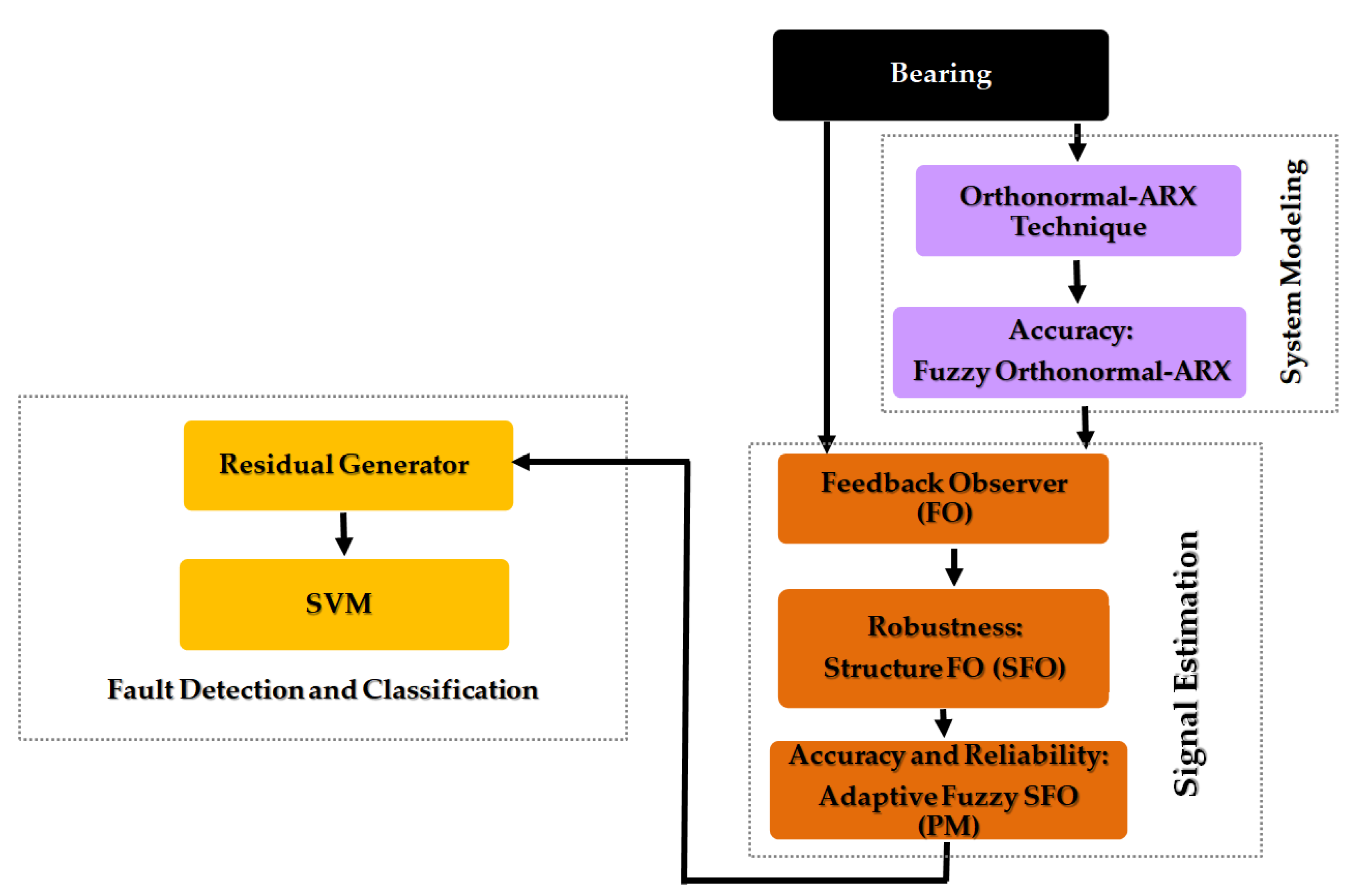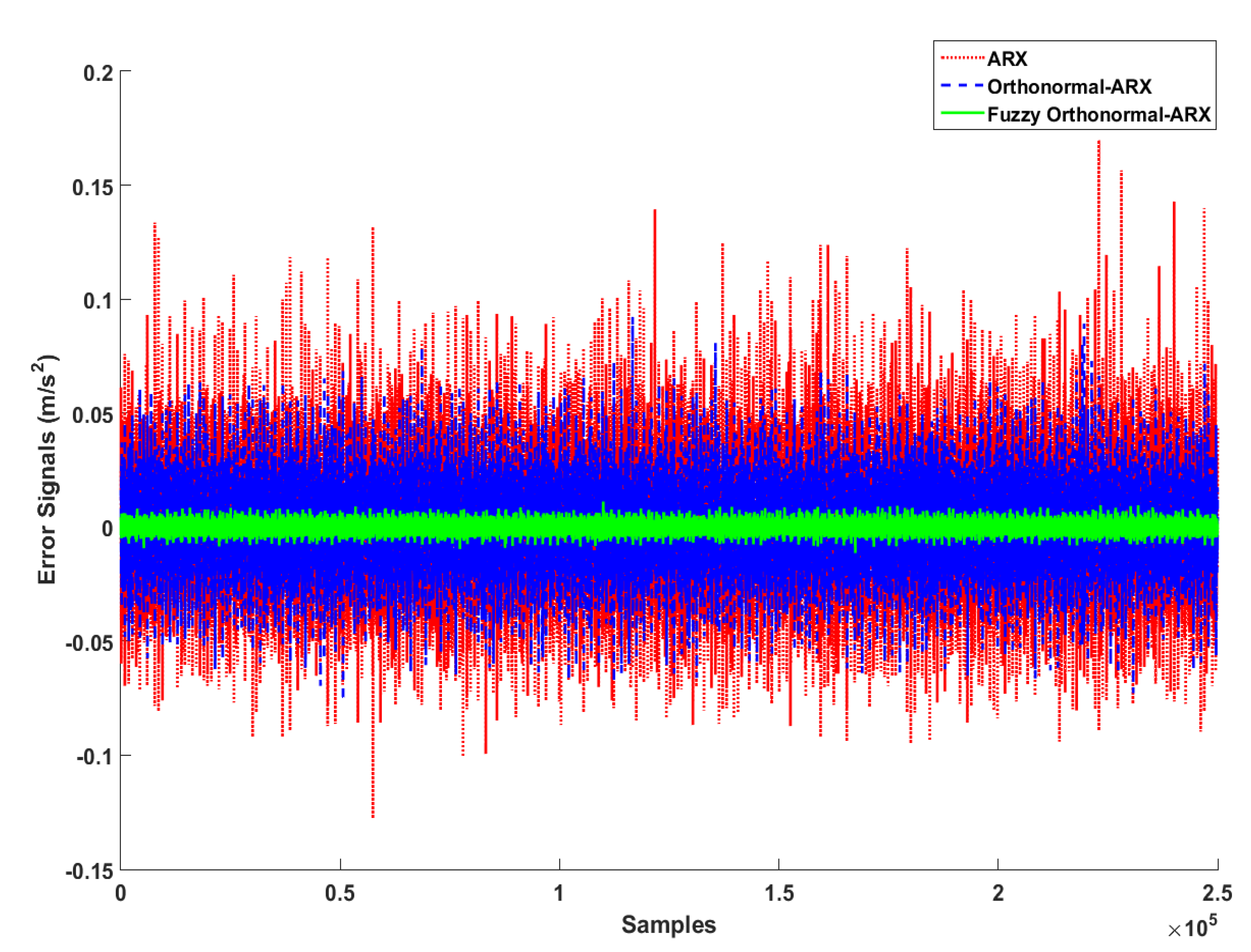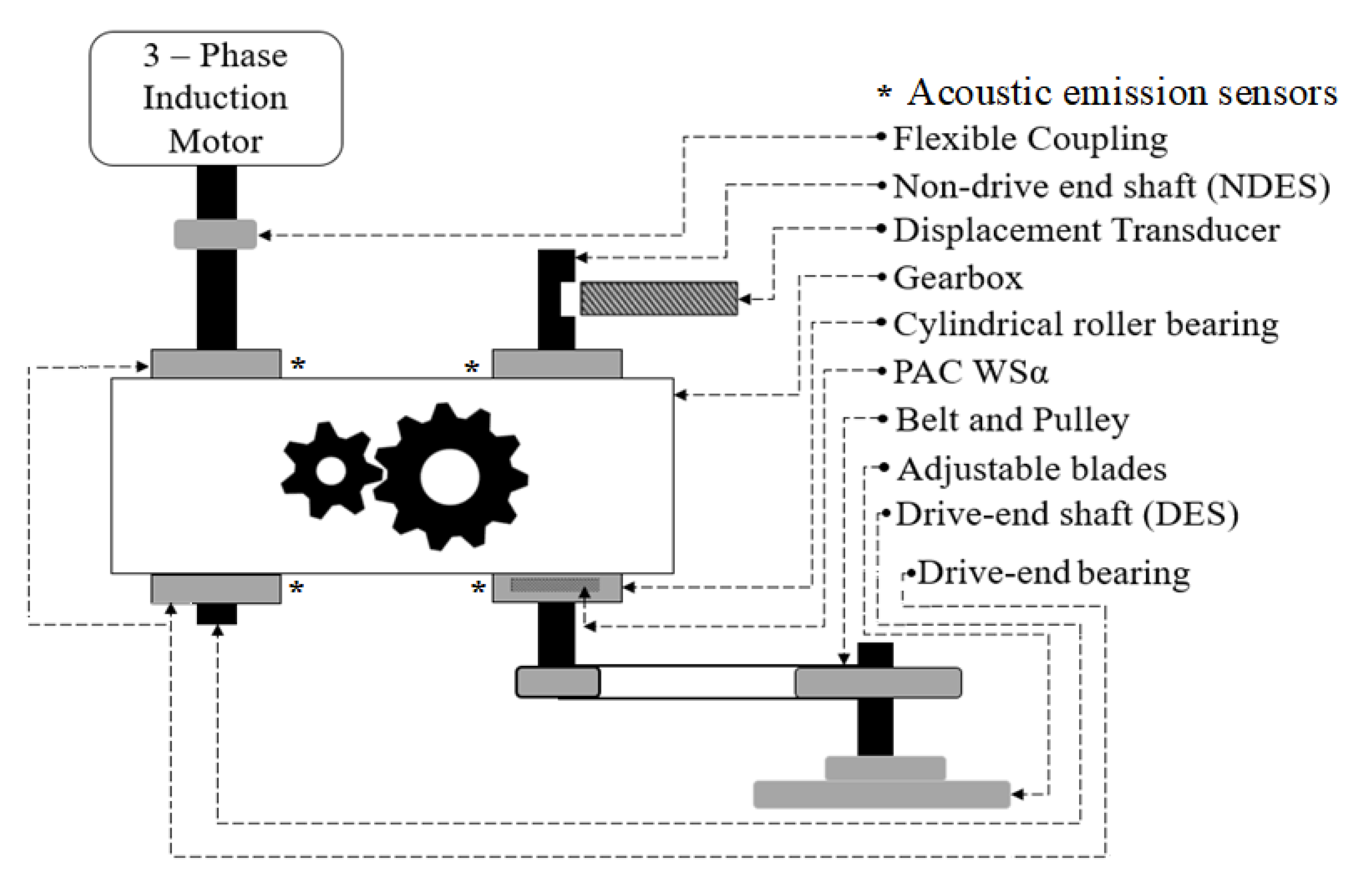3.1. Fuzzy Orthonormal-ARX Adaptive Fuzzy Logic-Structure Feedback Observer for Fault Estimation
The fuzzy orthonormal-ARX feedback observer is represented by the following definition,
To improve the accuracy uncertainty (e.g., motor speed variation) estimation of the fuzzy orthonormal-ARX feedback observer, the following definition can be defined.
Here, , and are the fuzzy orthonormal-ARX feedback observer for estimation state of the REB model, the fuzzy orthonormal-ARX feedback observer for estimation of the REB signal, the fuzzy technique for the non-linear part of the signal estimation, the fuzzy orthonormal-ARX feedback observer for estimation the uncertainty (motor speed variation) to minimize the error in normal conditions, the REB original signals, and the coefficient of the fuzzy orthonormal-ARX feedback observer, respectively.
As seen in
Figure 1, the fuzzy orthonormal-ARX feedback observer suffers from poor robustness, especially in unknown (crack-variant or speed-variant) situations. Therefore, the fuzzy orthonormal-ARX structure feedback observer is developed to overcome this obstacle. The following technique is used to improve the robustness based on multi-structure algorithm.
To improve robustness, the uncertainty can be estimated by the fuzzy orthonormal-ARX structure feedback observer based on the following definition,
Here, , and are the fuzzy orthonormal-ARX structure feedback observer for estimation state of the REB model, the fuzzy orthonormal-ARX structure feedback observer for estimation of the REB signal, the fuzzy orthonormal-ARX structure feedback observer for estimation the uncertainty (motor speed variation) to minimize the error in normal conditions, and the coefficient of the fuzzy orthonormal-ARX structure feedback observer, respectively.
Due to
Figure 1, the TSK fuzzy technique is developed and may be defined as follows [
22],
Hence, the fuzzy orthonormal-ARX fuzzy logic-structure feedback observer can be represented by the following equation,
In addition, the uncertainty signal estimation based on the fuzzy orthonormal-ARX fuzzy logic-structure feedback observer can be developed as follows:
Here, , and are the error estimations for the REB, the threshold value for tuning the estimation accuracy in TSK fuzzy algorithm, the uncertainty estimation based on fuzzy technique, coefficients, the fuzzy orthonormal-ARX fuzzy logic-structure feedback observer for estimation state of the REB model, the fuzzy orthonormal-ARX fuzzy logic-structure feedback observer for estimation of the REB signal, and the fuzzy orthonormal-ARX structure feedback observer for estimation the uncertainty (motor speed variation) to minimize the error in normal conditions, respectively.
Next, the adaptive technique is one of the best for increasing stability and reliability, especially in industrial applications. The structure surface coefficient and error surface coefficient are the main coefficients. Thus, the adaptive technique is developed to improve the stability and reliability of the fuzzy orthonormal-ARX fuzzy logic-structure feedback observer using the fuzzy orthonormal-ARX adaptive fuzzy logic-structure feedback observer (proposed method). In this work, a fuzzy algorithm is recommended for designing the adaptive algorithm. This technique is defined as follows:
where
and
are the adaptive tuning coefficients to improve reliability and the fuzzy output for tuning the coefficients. The two-input Mamdani fuzzy algorithm is used to develop the fuzzy output online tuning. The fuzzy inputs are the error estimation for the REB based on the fuzzy orthonormal-ARX fuzzy logic-structure feedback observer and the change of error estimation for the REB based on the fuzzy orthonormal-ARX fuzzy logic-structure feedback observer. Thus, the proposed method can be defined by the following equation,
The signal can then be estimated based on the proposed method and represented as follows:
Here, , and are the proposed method to obtain the error estimation for the REB, the proposed method to obtain the estimation state of the REB model, the proposed technique to obtain the estimation of the REB signal, and the proposed algorithm to estimate the uncertainty to minimize error and increase robustness in normal conditions.
3.2. Fault Detection and Fault Classification
Figure 1 shows that the proposed method minimizes the error in REB signal estimation in normal conditions. In this case, the residual signal
is minimized in normal conditions and is defined as follows:
Thus, a fault can be identified based on the differences between residual signals in different conditions.
Figure 3 illustrates the residual signals in normal and anomalous conditions based on the proposed method.
Due to the
Figure 3, the fuzzy orthonormal-ARX adaptive fuzzy logic-structure feedback observer is a suitable technique for detection and classification the signals. Moreover, to improve the fault detection and classification performance, the energy feature
is extracted from the residual signal and is introduced using the following equation,
Here,
is the
sample of the residual signal obtained by the fuzzy orthonormal-ARX adaptive fuzzy logic-structure feedback observer and
is the sample number.
Figure 4 shows the energy of the bearing signals in normal and anomalous conditions, such as a ball fault, an inner fault, and outer degradation. The figure shows that the proposed method, residual signal generation, and energy feature extraction are outstanding techniques for fault detection and identification.
Besides, the decision-making unit is developed to detect and classify the faults based on the difference between the amplitude of the residual signal’s energy. Therefore, to develop a decision-making unit, a support vector machine (SVM) that is a powerful mathematical technique is presented in this work. The soft margin SVM can be defined by the following equation [
20,
23,
24].
where
and
are the inputs, outputs, features, and maximum distance, respectively. The proposed technique to estimate, detect, and identify faults in the bearing is detailed in Algorithm 1.
| Algorithm 1. The proposed hybrid approach for fault diagnosis in a bearing. |
| 1: | Model the systems using the fuzzy orthonormal-ARX procedure (5) |
| 2: | Develop a fuzzy orthonormal-ARX feedback observer for signal estimation (6,7) |
| 3: | Develop a fuzzy orthonormal-ARX structure feedback observer to improve the robustness (8,9) |
| 4: | Improve the fault estimation accuracy using the fuzzy orthonormal-ARX fuzzy logic-structure feedback observer (11,12) |
| 5: | Develop the fuzzy orthonormal-ARX adaptive fuzzy logic-structure feedback observer to increase fault estimation accuracy, reliability, and robustness (14,15) |
| 6: | Generate the residual signal (16) |
| 7: | Run residual signal characterization by energy (17) |
| 8: | Apply the classification technique using SVM for fault diagnosis (18) |











